Pamukkale, a mesmerizing UNESCO World Heritage site in Turkey, beckons visitors with its captivating natural wonders. Travertine terraces, formed by the region’s mineral-rich thermal springs, cascade down a plateau, creating a serene and otherworldly landscape. Atop this plateau lies the ancient Roman city of Hierapolis, whose ruins offer a glimpse into the past. Exploring Hierapolis’ impressive theater, necropolis, and temple provides an opportunity to uncover the city’s rich history and understand its strategic importance. The therapeutic benefits of Pamukkale‘s thermal waters have been recognized since ancient times, drawing visitors seeking rest and relaxation amidst this captivating natural wonder. With its unique blend of history, culture, and natural beauty, Pamukkale and Hierapolis promise an unforgettable experience for those who venture to this remarkable destination.
Key Points
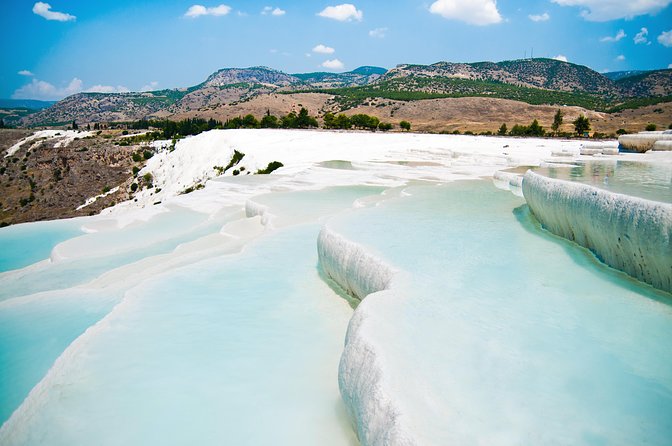
- Pamukkale is a natural wonder with thermal springs cascading down a hillside, creating mesmerizing travertine terraces and pools with therapeutic benefits.
- Hierapolis, an ancient Roman city situated atop the Pamukkale plateau, features well-preserved ruins such as a theater, necropolis, and Apollo Temple.
- The Nymphaeum, a 4th-century basilica in Hierapolis, showcases stunning architecture and intricate mosaics, providing insights into the city’s rich history.
- Visitors can explore the ancient Roman ruins of Hierapolis, which offer a glimpse into the vibrant past of this strategic and prosperous hub.
- The day trip from Izmir to Pamukkale and Hierapolis allows travelers to marvel at the stunning natural landscapes and enjoy the region’s rich history.
Tour Highlights
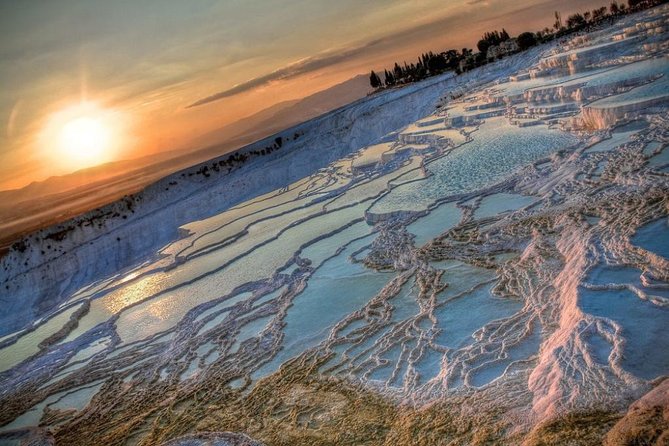
Visitors embark on a captivating day trip to marvel at the mesmerizing petrified lime cascades of Pamukkale and explore the ancient city of Hierapolis.
They’ll wander through the ruins of the Roman city, encountering the impressive Theater, Necropolis, and Apollo Temple.
The highlight is a visit to the 4th-century basilica, the Nymphaeum, which features stunning architecture and intricate mosaics.
Throughout the day, the group will learn about the therapeutic benefits of Pamukkale’s thermal spring waters, which the Romans once enjoyed.
With an included lunch and an English-speaking guide, this tour provides a comprehensive and immersive experience, transporting visitors back in time to uncover the rich history of this remarkable destination.
You can also read our reviews of more tours and experiences in Izmir.
Pamukkale’s Thermal Wonders
The thermal springs of Pamukkale cascade down the hillside, creating a mesmerizing landscape of petrified white terraces and turquoise pools.
Formed over centuries, these calcium-rich waters continue to deposit sedimentary limestone, shaping the distinctive travertine formations that have captivated visitors for millennia.
As the warm water flows over the terraces, it cools and leaves behind calcite crystals, building up the unique tiered structures.
Pamukkale’s thermal wonders have long been renowned for their therapeutic properties, with the ancient Romans flocking to these healing waters to rejuvenate their bodies.
Today, visitors can still experience the soothing benefits of these mineral-rich springs, marveling at the breathtaking natural phenomenon that has made Pamukkale a UNESCO World Heritage site.
Hierapolis: Ancient Roman City
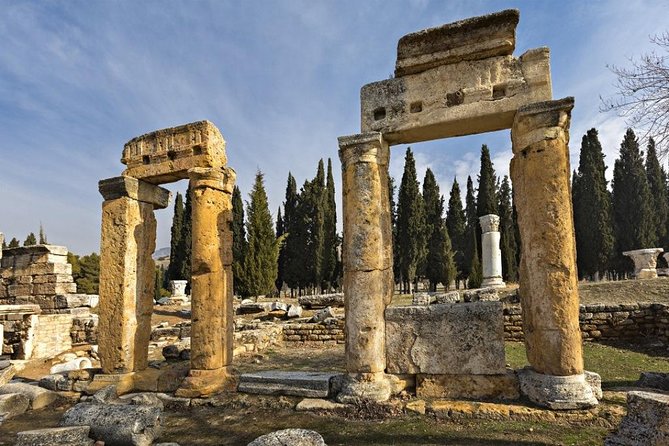
Perched atop a plateau formed over centuries by sedimentary limestone rock, the ancient Roman city of Hierapolis boasted a rich history and impressive architectural feats.
Established in the 2nd century BC, Hierapolis was once a bustling hub of activity, home to a vibrant theater, ornate temples, and an extensive necropolis.
Visitors can explore the ruins of the Apollo Temple, the 4th-century basilica known as the Nymphaeum, and the well-preserved theater that once hosted grand performances.
The city’s strategic location and natural thermal springs made it a popular destination for Romans seeking rest and relaxation.
Today, Hierapolis stands as a testament to the ingenuity and resilience of ancient civilizations, inviting modern-day travelers to uncover its hidden wonders.
Therapeutic Powers of Pamukkale
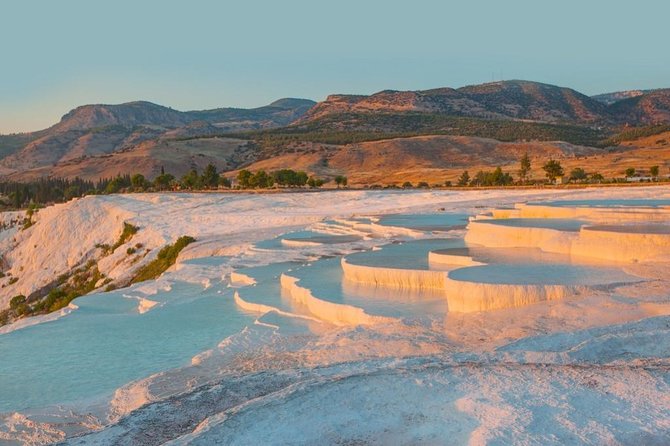
Pamukkale’s thermal spring waters continue to cascade down the hillside, leaving behind a stunning display of calcium-rich precipitates that have long drawn visitors seeking the therapeutic benefits of these soothing waters.
For centuries, the Romans recognized the curative properties of Pamukkale’s mineral-rich thermal baths, plunging into the pools to rejuvenate their bodies.
Today, travelers can still experience the restorative powers of these waters, which are believed to have healing effects on skin conditions, joint pain, and circulatory issues.
As the warm, mineral-laden water flows over the terraced travertine formations, it creates a serene and tranquil atmosphere, allowing visitors to bask in the therapeutic ambiance of this unique natural wonder.
Exploring Hierapolis’ Landmarks
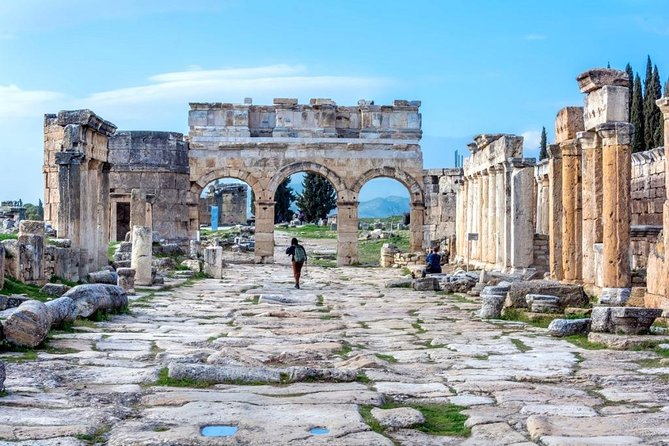
Nestled atop a plateau formed by centuries of sedimentary limestone, Hierapolis invites visitors to explore its ancient Roman ruins and uncover the stories etched into its well-preserved landmarks.
The city’s iconic Theater, a masterpiece of Roman engineering, once hosted grand performances and political events.
Adjacent to it lies the Necropolis, a sprawling cemetery where ornate sarcophagi and tombstones offer a glimpse into the lives of Hierapolis’ past inhabitants.
Nearby, the Temple of Apollo stands as a testament to the city’s devotion to its deities, its Doric columns and intricate carvings a testament to the skill of its builders.
Wandering through these captivating sites, visitors can’t help but feel transported back in time, immersed in the rich history of this remarkable ancient city.
Journey From Izmir to Pamukkale
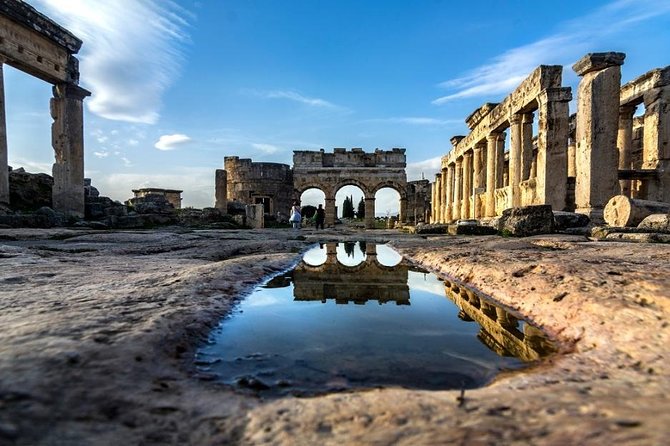
The tour begins with a comfortable journey from Izmir, as travelers are whisked away in an air-conditioned coach to the enchanting destination of Pamukkale. Along the way, the guide provides engaging commentary, sharing insights about the region’s history and natural wonders.
As the scenery transitions from bustling city to sprawling countryside, excitement builds in anticipation of the marvels that await. The drive is scenic, with rolling hills and lush greenery providing a picturesque backdrop.
Upon arrival, the first glimpse of Pamukkale’s iconic white terraces cascading down the hillside is a truly breathtaking moment, setting the stage for an unforgettable exploration of this natural and historic wonder.
Practical Information and Logistics
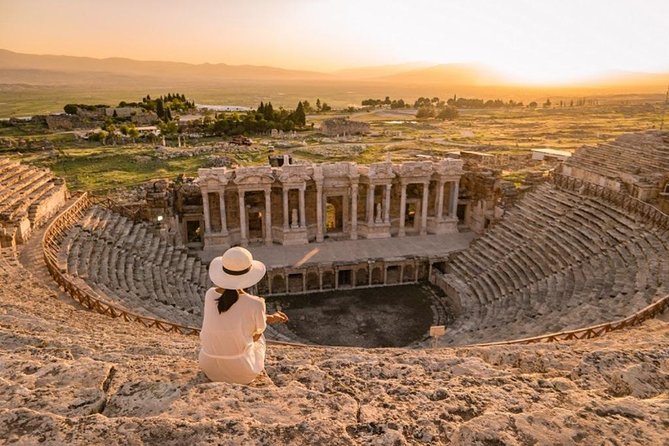
Upon arrival at Pamukkale, travelers can expect a seamless experience with the tour’s practical information and logistics. The tour includes hotel pickup and drop-off, ensuring a convenient start and end to the day’s adventure. Confirmation is provided at the time of booking, allowing guests to plan their schedule with confidence.
| Accessibility | Not wheelchair accessible, not recommended for children under 4, travelers with back problems, or pregnant women |
|---|---|
| Group Size | Minimum number of travelers required, otherwise offered a different date/experience or full refund |
| Inclusions | English-speaking local guide, transport by air-conditioned coach, lunch |
| Duration | Day trip |
| Tour Activities | Marvel at Pamukkale’s petrified lime cascades and ancient Hierapolis, visit Roman ruins, explore the 4th-century basilica |
Tour Reviews and Ratings
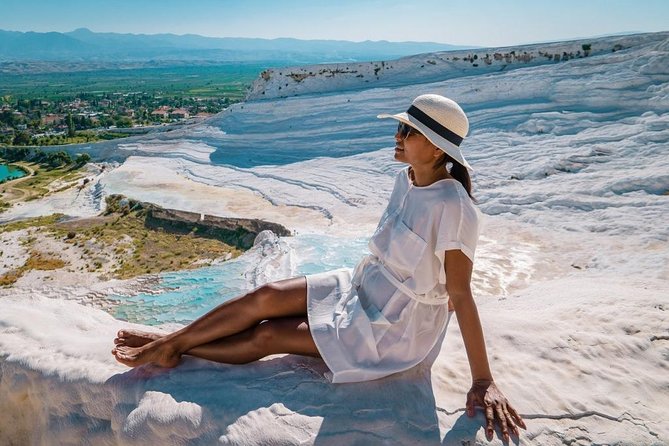
Travelers have left 63 reviews for this tour, awarding it an overall rating of 4.0 out of 5.
Reviewers praised the knowledgeable and friendly local guide, who helped bring the ancient sites of Pamukkale and Hierapolis to life.
Many noted the tour’s efficient organization, with comfortable transportation and a convenient lunch included.
Visitors were captivated by the stunning natural beauty of Pamukkale’s white travertine terraces and the well-preserved ruins of Hierapolis.
A few reviewers wished for more free time to explore at their own pace, but the majority described the tour as an excellent value that allowed them to make the most of their day trip.
Frequently Asked Questions
What Is the Recommended Clothing for the Tour?
The recommended clothing for this tour is comfortable, lightweight attire suitable for walking. Visitors should wear closed-toe shoes, as the terrain can be uneven. Bringing a hat, sunscreen, and water is also advised to stay comfortable throughout the day.
Can We Stop for Souvenirs or Shopping During the Trip?
The tour typically includes a stop for souvenirs or shopping, allowing travelers to browse local handicrafts and Turkish specialties. However, the duration of this stop is limited, so travelers should plan their shopping accordingly.
Are There Any Restrictions on What We Can Bring?
Travelers can generally bring personal items like cameras, water bottles, and snacks on the tour. However, it’s best to avoid large bags or luggage, as there may be restrictions on what can be carried onto the sites.
Is There an Option to Extend the Tour Duration?
Yes, there may be an option to extend the tour duration. Customers should inquire with the tour operator about the possibility of adding extra time to explore the sites more thoroughly or visit additional nearby attractions.
Can We Take a Dip in the Thermal Pools at Pamukkale?
Yes, visitors can take a dip in the thermal pools at Pamukkale. The calcium-rich waters are known for their soothing, therapeutic qualities, which the ancient Romans once enjoyed. Guests can experience the relaxing qualities of these natural thermal springs.
Recap
Pamukkale’s captivating thermal pools and ancient Hierapolis offer a truly unique experience.
Visitors can enjoy the restorative thermal waters, explore the well-preserved ruins, and gain insights into the region’s rich history.
From the stunning white travertine terraces to the awe-inspiring archaeological sites, Pamukkale is a must-visit destination that seamlessly blends natural wonders and cultural heritage.
More Tour Reviews in Izmir
- Izmir: Private Ephesus Full-Day Tour with Lunch
- From Izmir: Ephesus and House of Virgin Mary Private Tour
- Izmir: Çeme, Alaçat, Seferihisar and Sack Tour
- From Izmir: Pamukkale, Hierapolis and Karahayit Day Tour
- From Izmir: Ephesus Ancient City Day Tour w/Lunch
- Ephesus Ancient City with Best Guides Only For Cruise Guests
Not for you? Here's more things to do in Izmir we have recnetly reviewed
- From Izmir: Private Day Trip to Acropolis of Pergamon
- Ephesus: Mary’s House Tour with Tickets + Lunch For Cruisers
- From Izmir: Pamukkale Full-Day Tour
- Izmir: Ephesus and The House of The Virgin Mary Tour
- Ephesus and Sirince Tour from Izmir / Kusadasi
- Izmir: Private Guided Ephesus Tour with Skip-the-Line Ticket
- Izmir: Pergamum Tour with Private Guide & Van
- Ephesus & Sirince Village Tour from zmir
- From Izmir: Full Day Boat Trip around Cesme with BBQ Lunch
- Izmir : Ephesus and Sirince Guided Tour
- From zmir Port : zmir City Tour – Colors of Izmir
- Jewish Heritage Tour
